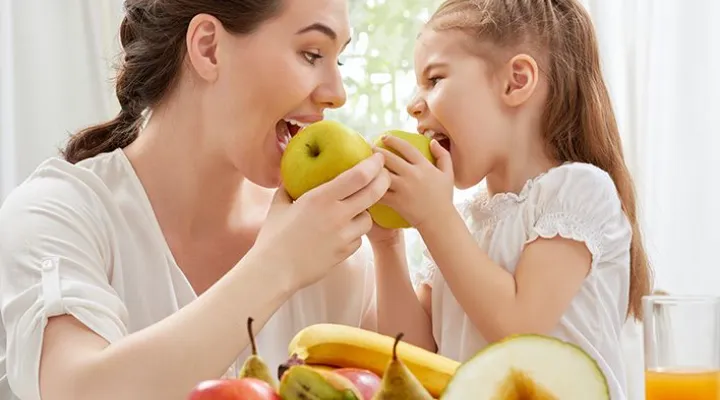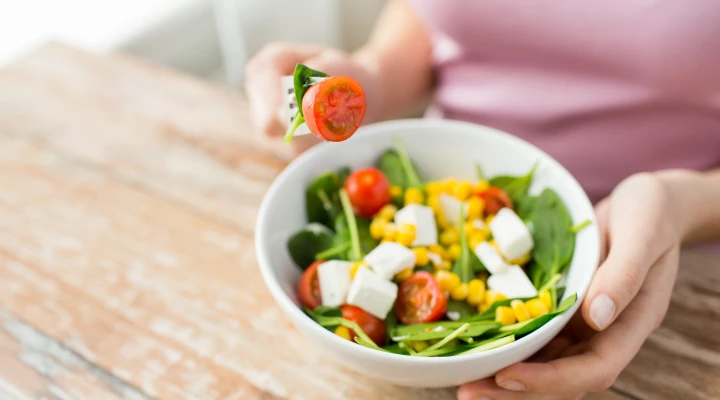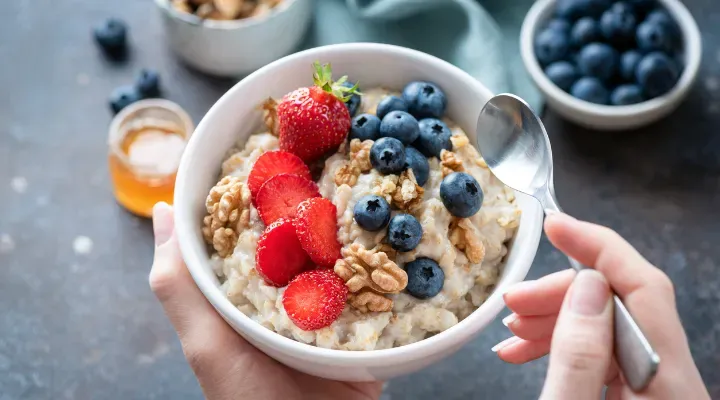Eating at least 1-2 portions of fruit per day is recommended. However, I often find it challenging to fit it into one’s daily schedule. Taking advantage of the abundant summer supply can help. Here are some inspiration and tips to make fitting fruits into our diet easier.
Why is it worth eating fruits?
Fruit is rich in beneficial nutrients. Most importantly, they contain vitamin C and beta-carotene. The daily requirement of vitamin C for a healthy adult is about 100 mg, which can be met by eating various fruits and vegetables without supplements. In addition to citrus fruits, berries (mainly currants, but also strawberries, strawberries, gooseberries, and raspberries), melons, cherries, apricots, and southern fruits such as kiwis and pineapples are rich in vitamin C. As vitamin C is degraded by heat, it is best to eat these fruits fresh.
Beta-carotene is an essential precursor of vitamin A, vital for vision, skin health, and immune function, among other things. It is also a plant coloring agent. Therefore, it is worth eating a variety of fruits of all colors. In this way, we can ensure that we get enough beta-carotene and polyphenols, which have anti-inflammatory effects, can prevent lifestyle illnesses, and help keep us healthy.
Fruits are also rich in minerals, particularly potassium and magnesium. A diet rich in fruit and vegetables is an essential pillar that protects the cardiovascular system and prevents high blood pressure.
Their fiber content helps maintain the intestinal flora's balance and regular bowel movements. Their water content can also contribute to fluid intake to a small extent.
Do fruits raise blood sugar levels?
Fruits also contain carbohydrates in the form of sugars such as glucose, fructose, and sugar alcohols. They contain no or very little fat (except avocados) and protein. This also contributes to the fact that their sugar content is easily and quickly absorbed and can increase blood sugar levels when it enters the bloodstream. The advantage of this is that fruits quickly refresh and provide energy.
However, this effect is not beneficial for people with diabetes, while fruit consumption is very healthy because of the abovementioned benefits. It is not forbidden for people with diabetes; it is highly recommended. The sudden spike in blood glucose levels can be counteracted by being mindful of when to eat fast carbohydrates, sticking to the quantity recommendation (which is individualized, but usually 1-2), and eating foods with higher fiber, protein, or fat content There are a few fruits that people with diabetes should pay particular attention to, as they can cause a rapid rise in blood sugar levels or it is easy to exceed the recommended intake. Examples include watermelon, grapes, figs, and cherries.
Overall, fruits’ energy content is not high. The only exceptions are a few, such as avocados and bananas. Therefore, it can be essential to change one's lifestyle or even eat in proper proportions.
What about fruit preparations?
Fruit juices, syrups, jams, and dried fruit contain concentrated fruit sugars. Due to heat treatment, their fiber content is often significantly lower, and they also have lower vitamin C content. However, they can be rich in polyphenols, and dried fruit is high in potassium.
The presence of fruit preparations can be moderate in a healthy diet because of their high energy content. Fruit juice should be drunk occasionally, not instead of water. Choose syrups and jams with lower sugar content. Watch the portion size of dried fruits (half or one closed handful). These products are not recommended for people with diabetes; they are recommended rarely and in small quantities.
When should you eat fruit?
Fruits can contribute to our breakfast's flavor and vitamin content; they can be added to porridge and muesli or can be rolled in pancakes. They can also be eaten at teatime or for a snack, perhaps with a few biscuits, an oil seed, or a spoonful of seed cream. You can make yogurt or cottage cheese with fresh or tinned fruit or use it as a filling or in cakes. The healthiest dessert after lunch is a piece of fruit. Summer can be a season not only for canning but also for making fruit ice cream.
In diabetes, the best time to eat fruit is at lunchtime, possibly after lunch or after lunch for dessert, given the body's insulin sensitivity.
What can we do if our children don't like fruits?
Be patient, offer the ones they like, and gradually introduce the others. Shop and choose together. It's fun to pick your own; if you don't have one in grandma's garden, you can participate in a pick-it-yourself promotion. Let's play, talk, and build not only on the taste of the fruits but also on their color, smell, and touch. Learning about taste can be helped by eating fruit products in moderation, especially homemade ice cream. If our children's diet is very restricted, it is worth contacting a pediatrician or dietician for further help.
Finally, always remember to wash fruits. After spraying, wait for the prescribed time, and do not eat any moldy or rotten pieces.
- pediatrics21
- dietetics20
- RMC Dental Center15
- diet13
- internal medicine11
- dentistry9
- pediatric dentistry8
- sport7
- Dr Kinga Jókay7
- coronavirus6
- screening6
- covid6
- urology6
- obstetrics gynecology6
- prevention5
- cardiology5
- allergy5
- psychology5
- dental hygiene5
- infection4
- gastroenterology4
- menopause4
- screenings3
- Kinga Jókay M.D3
- Flu shot3
- Flu3
- women's screening3
- zsuzsanna kókai2
- Dr Nóra Gullai2
- infectious disase medicine2
- Ear-Nose-Throat2
- heat stroke2
- endocrinology2
- Dr Tímea Baló2
- allergen immunotherapy2
- Adrienne Nagy M.D.2
- Fetal Medicine Center2
- pediatric urology2
- flu season2
- meningitis2
- dermatology2
- gynecologist2
- Ophthalmologist2
- Headache Clinic2
- Dr Eszter Bodnár2
- headache2
- menopause program2
- invisalign2
- diabetology2
- cardiovascular disease1
- diabetes1
- hydration1
- hematology1
- iron1
- Imre Bodó M.D.1
- Same Day Surgery Center1
- nutritional disorder1
- lyme disease1
- gynecologic oncology surgery1
- first trimester screening1
Our related doctors
Any questions before booking an appointment?
If you are unsure which doctor to see or what examination you require, we are here to help!
Simply request a free callback from one of our colleagues, who will help you find the right specialist based on your specific issue.













